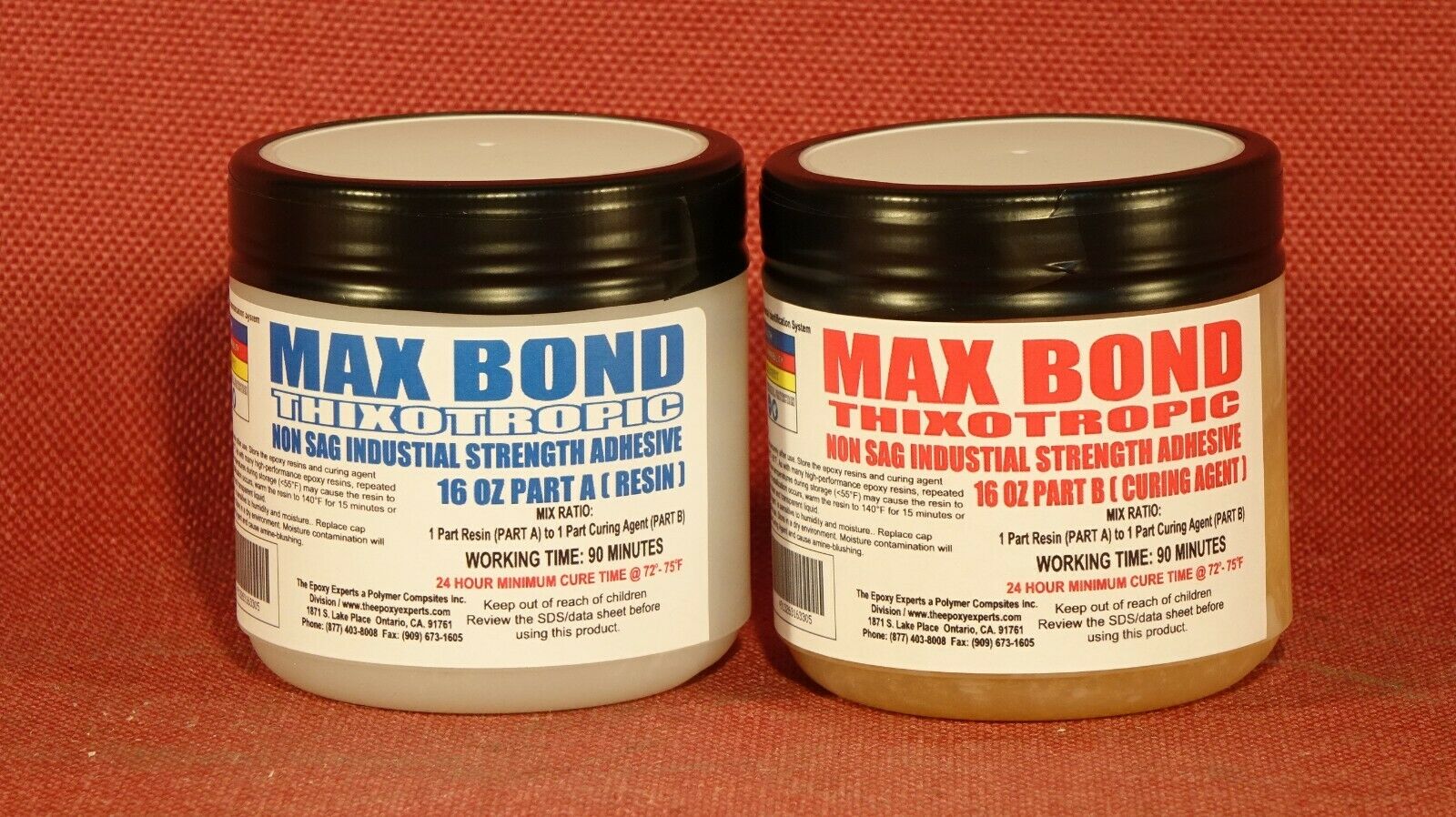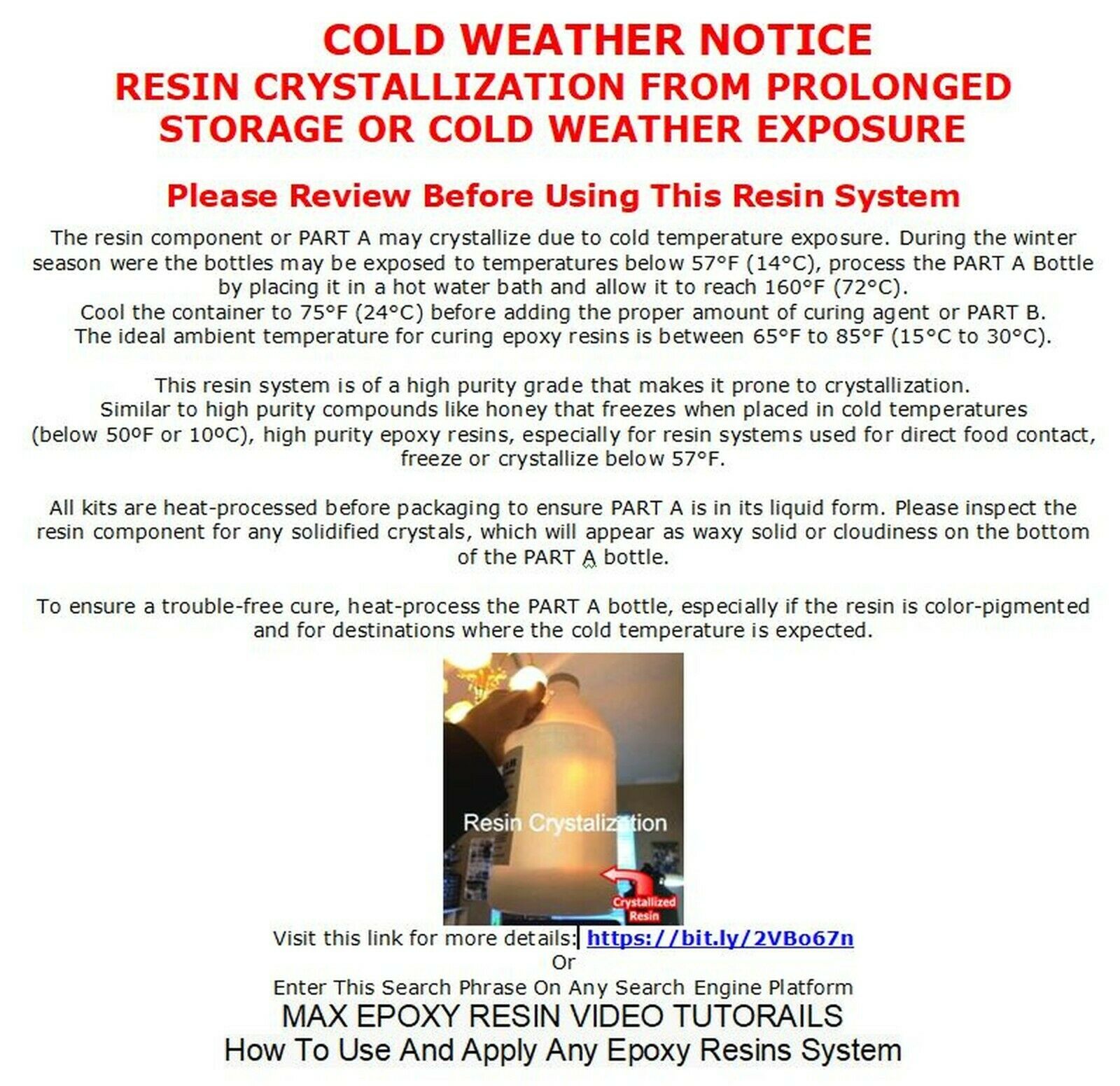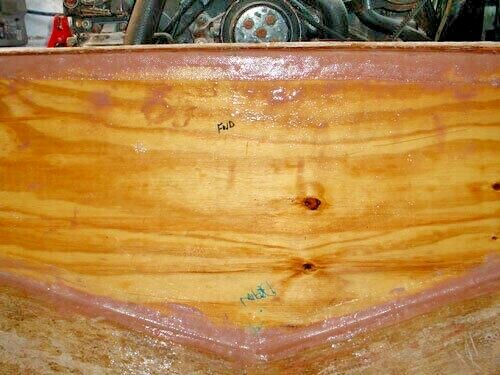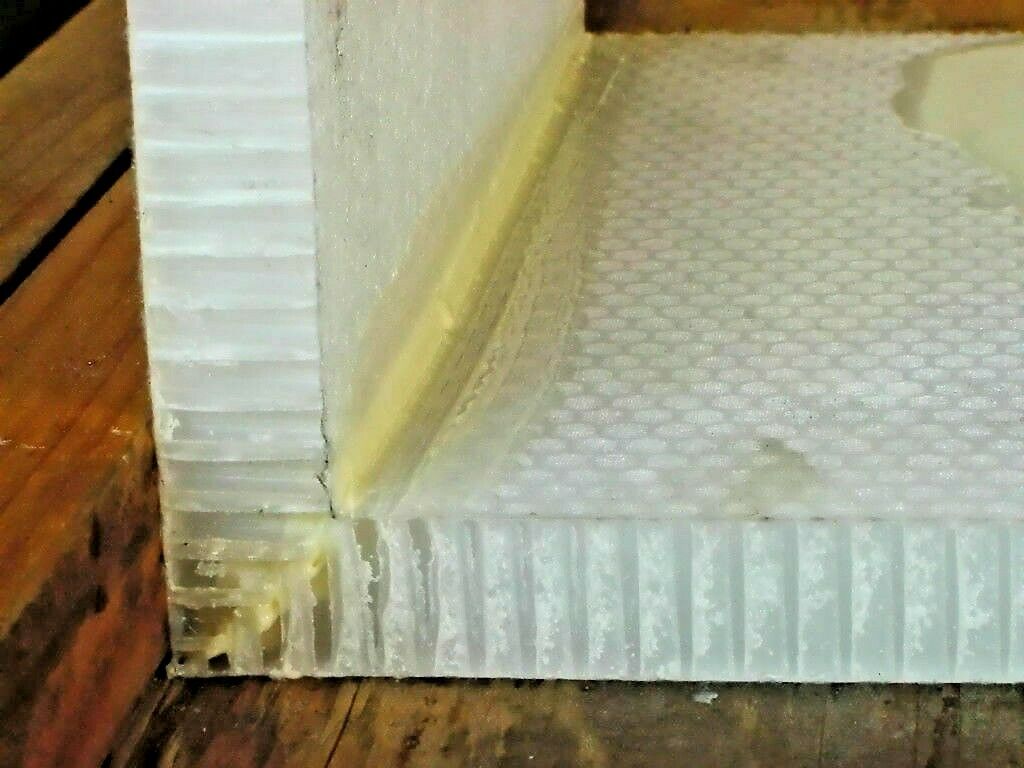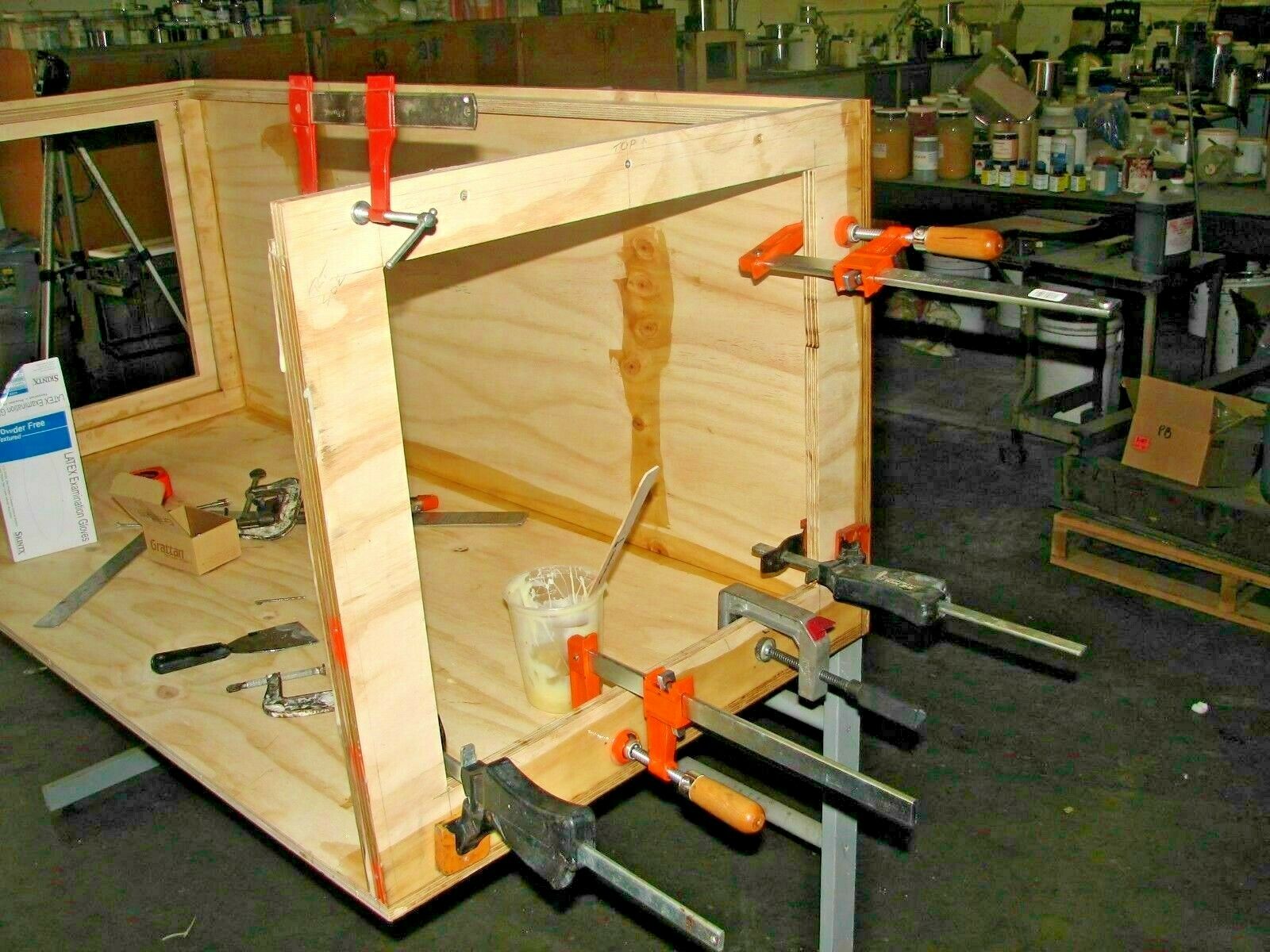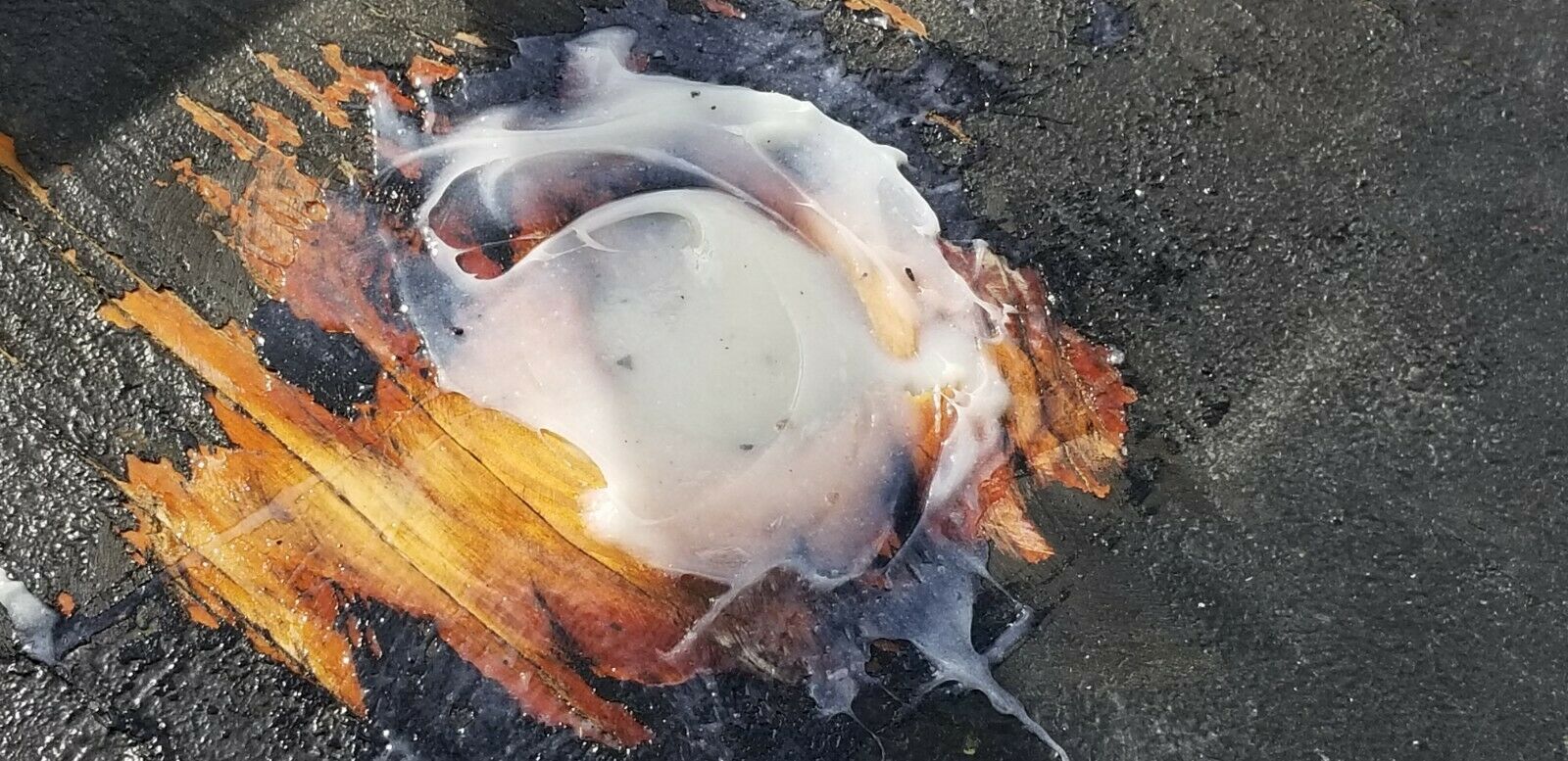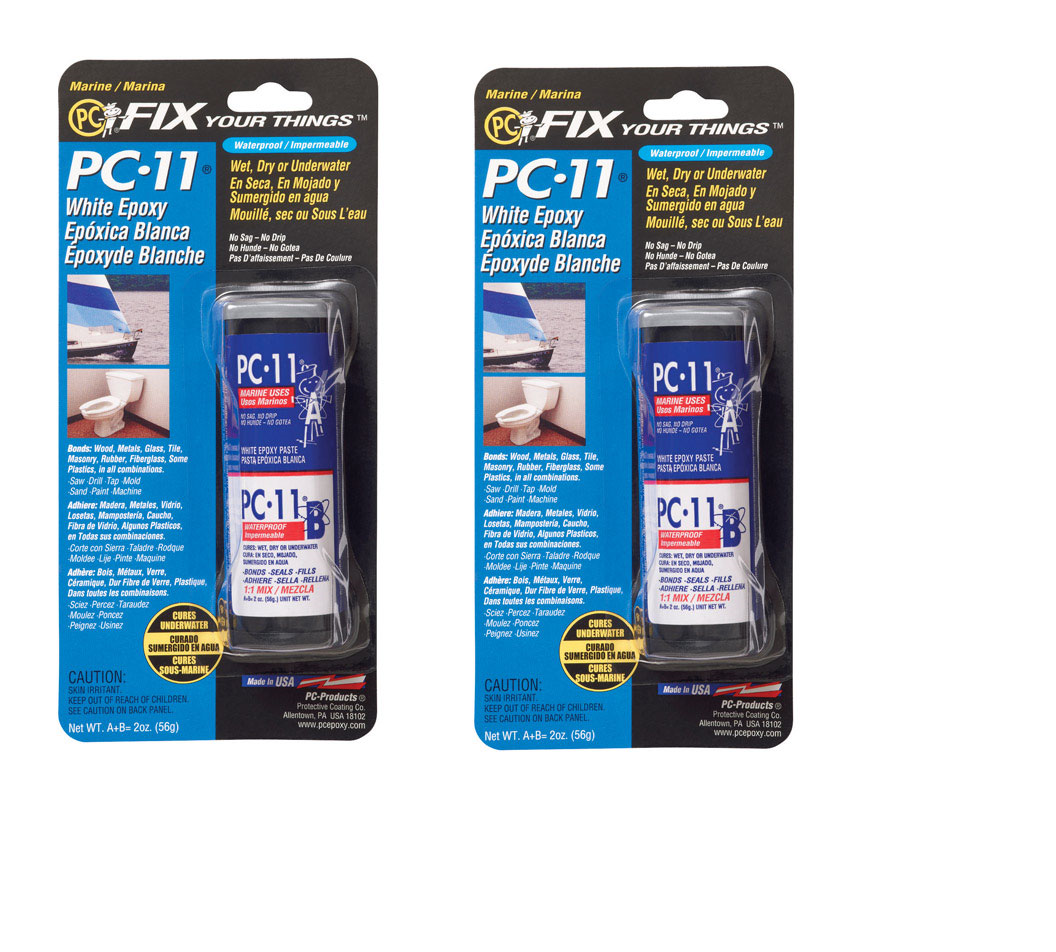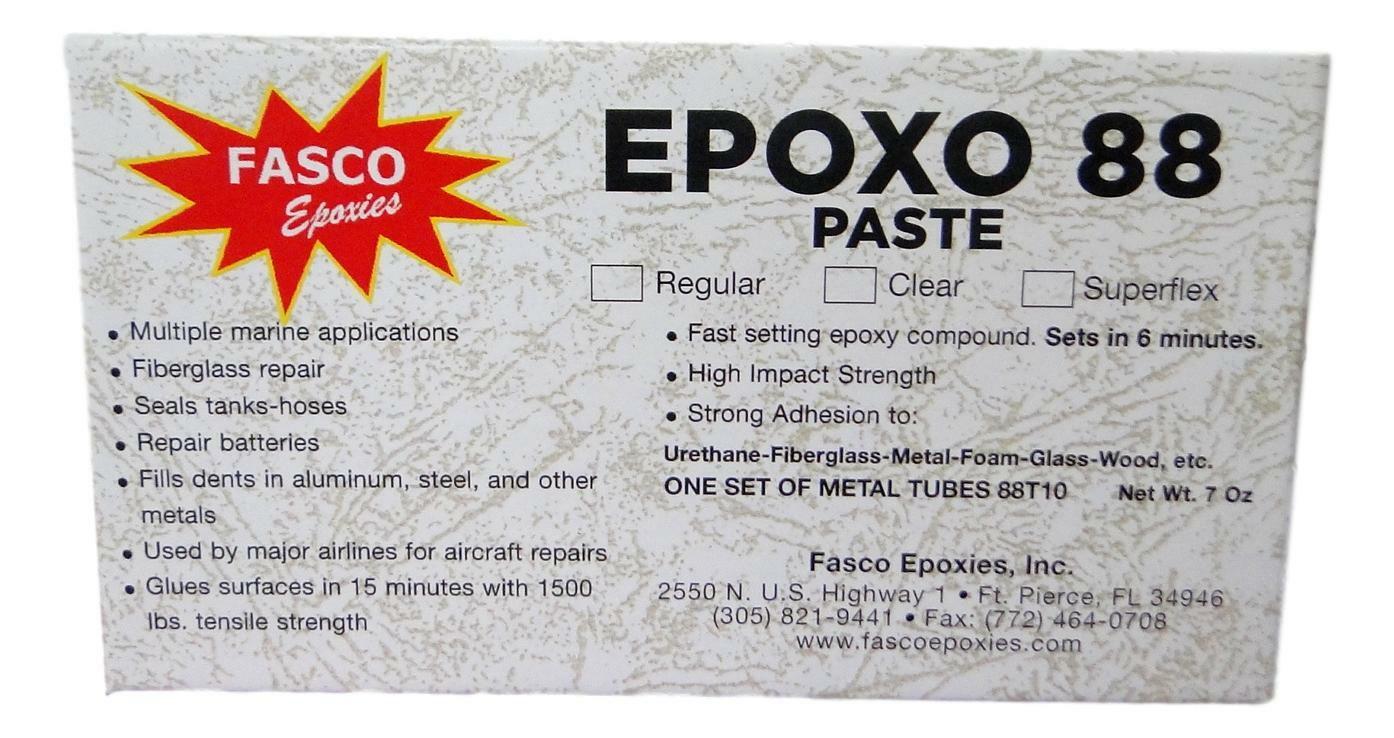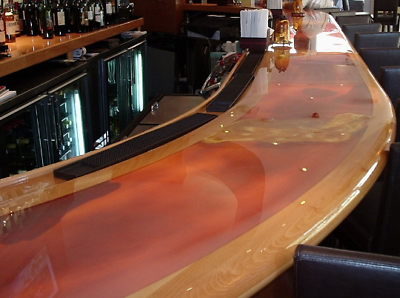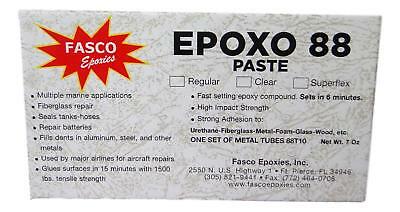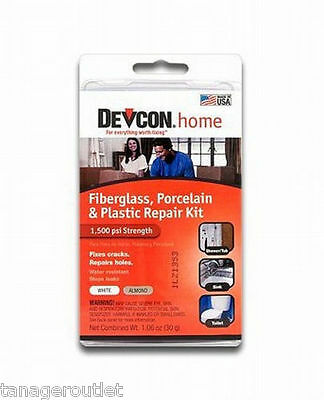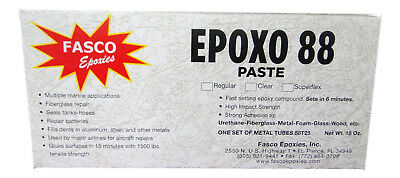-40%
EPOXY RESIN BOAT BUILDING STRONG GLUE 4 METAL WOOD FIBERGLASS STEEL CONCRETE
$ 13.05
- Description
- Size Guide
Description
MAX BOND THIXOTROPIC A/BHigh Strength Epoxy Adhesive
Non-Sagging Or Thixotropic
Consistency
(Will Not Flow At Rest But Easily Spread)
This money-saving 32-ounce kit is a handy item for hobbyists,
marine and aircraft repair, construction and other critical bonding applications.
DESCRIPTION
MAX BOND THIXOTROPIC A/B is a two-part modified epoxy/polyamide based adhesive system specially formulated to provide structural bond strength to a variety of substrates. It is a thickened version of the MAX BOND System where flow control on a vertical or overhead application. When used in heat-cured applications, MAX BOND THIXOTROPIC A/B will demonstrate minimal or controlled flow eliminating excessive resin run-off and resulting in a clean adhesive placement.
MAX BOND THIXOTROPIC A/B exhibits structural bond strengths to numerous substrates commonly used in composites industry such as steel, aluminum, metals and alloys, resin impregnated composites, and most plastics. It performs well in wide range of service temperature and resists cracking and delamination due to cyclic vibration, thermal expansion and contraction.
Conforms To Hundreds of Aerospace/Military/Naval Materials Specifications
MIL-A-8623 Type 1
MS-511
MMM-134 Type1
OS-9923A
Boeing BMS-5-29
NASA Requirements For Low Outgassing Polymers
(<1% CVCM, collected volatile condensable material )
Conforms To Code Of Federal Regulations
FDA CFR Title 21 175.300 For Direct/indirect Food Contact Adhesive
Important Guidelines For Food Contact Applications
For food contact applications, MAX BOND THIXOTROPIC A/B must be fully cured to ensure no chemical leaching can occur when foodstuffs' come in contact with the cured resin system. Any uncured chemical compounds from the improperly prepared MAX BOND THIXOTROPIC may be extracted and cause cross-contamination or leaching during food contact. Please review the following and to avoid any curing problems.
·
Check for resin crystallization. During the colder season, the MAX BOND THIXOTROPIC resin component or PART A may crystallize and must be heat-processed to fully polymerize the resin system. Inspect the PART A bottle for any turbidity or a solid mass that typically forms on the bottom of the bottle.
Weigh or measure the components accurately at a 2:1 mix ratio. Any off-ratio excess of either the resin or curing agent in the mixture can cause poor cure and can cause chemical leaching that can transfer to the food or beverage. Use a digital scale and weigh each component for best results, for example, 200 grams of MAX BOND THIXOTROPIC PART A will require 100 grams of
MAX BOND THIXOTROPIC PART
B. This digital scale is available on eBay for purchase.
Purchase this scale with any of product offering and the shipping cost of the scale is free.
Please request a total before paying for combined shipping savings.
https://www.ebay.com/itm/222630300203
·
Mix the components thoroughly. Any unmixed component from poor mixing will result in poor polymerization and can be extracted and cross-contaminated the foodstuffs. Please view the following mixing demonstration below;
SEE MIXING DEMO BELOW
·
Allow the applied resin to fully cure for a minimum of 48 hours at 75°F before exposing the coating to any food or beverage. A short heat post cure at 150°F for 60 to 90 minutes will ensure the resin is fully cured. Rinse the cured coating with warm water and mild detergent before allowing any food contact. If an oven is not available, an infrared heat lamp will work well for heat.
POSSIBLE HEAT CURING TECHNIQUES
If an oven is not available to provide the needed thermal post cure, exposing the assembled part to solar heat (sun exposure) for a short period will provide enough heat cure for the part to be handled.
Other heat curing such as infrared heat lamps can be used if a heat chamber or oven is not available.
MAX BOND A/B SERIES VISCOSITY COMPARISON
AVAILABLE IN THREE VERSIONS
MAX BOND THIXOTROPIC A/B
HONEYCOMB ADHESIVE CORE SPLICING AND EDGE CLOSE-OUT
NON-SAG OR THIXOTROPIC VERSION FOR BONDING AND ADHESIVE APPLICATIONS
32 OUNCE KIT
https://www.ebay.com/itm/222624260837
64 OUNCE KIT
https://www.ebay.com/itm/311946479917
1 GALLON KIT
https://www.ebay.com/itm/222624293631
2 GALLON KIT
https://www.ebay.com/itm/222623988841
Physical Properties
Mixed Density
1.10 gm/cc
Form and Color
Thixotropic Gel
Part A – Resin
White Thixotropic Liquid
Part B - Curing Agent
Amber Gel
Viscosity Mixed
135,624 cPs @ 77°F (25ºC)
Mix Ratio
1:1 -Equal Parts Volume Or Weight
Working Time (200-gram mass)
85 Minutes @ 77°F (25ºC)
Peak Exotherm (200-gram mass)
160°F
Cure Time
24 Hrs. Minimum
Accelerated Cure
2 Hours Room Temperature
Plus 1 hour 212
o
F
Mechanical Properties
Hardness
85 ± 5 Shore D
Tee-Peel Strength
4 Lbs. per inch Width
Compressive Strength
15,800 psi @ 77°F (25ºC)
Tensile Shear Strength
3,700 psi @ 77°F (25ºC)
2,200 psi @ -112°F (-80ºC)
1,450 psi @ 212°F (100ºC)
Elongation Maximum Yield
2.3%
Tensile Strength
8,800 psi
Service Temperature
-67°F to 250°F
Thin Film Set Time
120 minutes
CHEMICAL RESISTANCE TEST
10 Day Soak Test @ 77°F (25°C)
Test Solvent
% Change in weight
Distilled Water
.23
Sulfuric Acid 30%
1.9
Nitric Acid
3.8
Toluene
3.7
Sodium Hydroxide
10.00
Anti-Freeze
No Effect
Motor Oil soak
No Effect
Viscosity Comparison Chart
MATERIAL
VISCOSITY (centipoises)
Water @ 70° F
1-5
Blood or Kerosene
10
Anti-Freeze or Ethylene Glycol
15
Motor Oil SAE 10 or Corn Syrup
50-100
Motor Oil SAE 30 or Maple Syrup
150-200
Motor Oil SAE 40 or Castor Oil
250-500
Motor Oil SAE 60 or Glycerin
1,000-2,000
Corn Syrup or Honey
2,000-3,000
Black-strap Molasses
5,000-10,000
Hershey Chocolate Syrup
10,000-25,000
Heinz Ketchup or French’s Mustard
50,000-70,000 THIXOTROPIC
Tomato Paste or Peanut Butter
150,000-200,000 THIXOTROPIC
Crisco Shortening or Lard
1,000,000-2,000,000
Caulking Compound
5,000,000-10,000,000
Window Putty
100,000,000+
Volume And Weight Factors That Relates To Any Undiluted Epoxy Resin As A Guide:
1 GALLON = 231 CUBIC INCHES
1 GALLON OF RESIN CAN COVERS 1608 SQUARE FEET
1 MIL OR 0.001 INCH CURED COATING THICKNESS
1 GALLON OF RESIN IS 128 OUNCES
1 GALLON OF MIXED EPOXY RESIN IS 9.23 POUNDS
1 GALLON OF RESIN IS 3.7854 LITERS
Mixing Instructions
Dispense equal parts of Part A and Part B and mix thoroughly until a homogeneous consistency is achieved. The mixture will turn translucent milky amber but will clarify when applied in a thin film during curing. Transfer the mixed resin into another clean container and mix for another minute and use.
For mix metering application, ensure that an equal flow rate of Part A and Part B is achieved. A 24 element static mixer provides excellent mix results. Attach the static mixer and dispense and discard approximately 1-ounce material before using the material. Dispense the material in on the corner of the component casing and allow the material to completely flow throughout. This technique will reduce voids and air entrapment.
The use of a weighing scale is highly recommended for proportioning the components. The resin systems used for direct food contact must yield absolute cure to ensure no chemical leaching can occur when the cured coating comes in contact with the foodstuff. Improper or poor mix ratio accuracy from using volumetric measurement may cause inaccuracy which may cause uncured components to leach from the applied coating. Use a digital scale to precisely weigh the resin and curing agent and ensure full polymerization of the resin and curing agent and prevent leaching
.
Purchase this scale with any of product offering and the shipping cost of the scale is free.
Please request a total before paying for combined shipping savings.
https://www.ebay.com/itm/222630300203
Step 1. Equal Parts Resin And Curing Agent By Weight Or By Volume
Step 2. Mix gently but thoroughly
as not introduce excessive air entrapment
Step 3. Mix For 3 To 5 Minutes Or Until Uniform
Step 4. Ready To Use
Usage And Applications Instructions
MAX BOND THIXOTROPIC adhesive is specially formulated so that the adhesive will not flow allowing the user precise and clean adhesive placement.
MAX BOND THIXOTROPIC is paste-like in consistency.
MAX BOND THIXOTROPIC is a general purpose high strength adhesive is used in all types of bonding application where excellent water resistance and a wide service temperature exposure is expected. This resin system is an industry "workhorse" standard and is the most versatile system available. It can also be used as a reinforcing resin for Fiberglass, Aramid ( Kevlar Type) Fibers, Carbon Fiber or as crack filling resin and surface sealing for many different types of substrates.
Used In Hundreds Of Structural Bonding Applications
Marine And Aircraft Repair
Fiberglass To Fiberglass Bonding
Filleting Compound
Rod Building Golf Club Assembly
Concrete Bonding, Patching, Sealing
Woodwork Bonding, Filleting For Corner Joints
Composite Adhesive, Laminating
Honeycomb Bonding And Edge Closeout
MAX BOND THIXOTROPIC does not contain nonreactive plasticizer that typically deteriorates the cured property over time. It is approved for direct and indirect food contact applications.
Measure equal amounts of Part A and Part B, mix and apply and allow to cure overnight. It has a 90-minute working time and can be handled in 6 hours. A strong bond will develop in 10 hours of room temperature curing and will fully cure within 24 to 36 hours.
Heat curing is also ideal for a faster cure time and will maintain its non-flowing properties at elevated temperatures. The mixed consistency is similar to peanut butter and is easily applied using a brush, spatula, trowel or injected into place using a syringe.
Surface Treatment Prior To Bonding
In virtually every application the quality of the bond between the resin system and the surface to which it is applied is improved if the surface is clean and dry. This is particularly true of adhesive applications where stress will be applied to the cured bond line.
It is also true where protective coatings are used. The following surface preparation procedures are recommended.
METALS
Degrease – Wipe laying surfaces with Methyl Ethyl Ketone (MEK) or acetone to remove all oil, dirt, and grease.
Etch –
For optimum results, metal parts should be immersed in a chromic acid bath solution consisting of:
Sodium dichromate – 4 parts by weight
Sulfuric acid – 10 parts by weight
Water – 30 parts by weight
The solution should be held at a temperature of 160°F (71°C), and the parts left immersed for 5 to 7 minutes.
Rinse – Remove metal parts from etching bath and rinse in clean cold water (de-ionized water is recommended). If thoroughly clean, metal surfaces so treated will hold a thin film of water.
Dry – To accelerate drying, items to be bonded can be placed in an air-circulating oven.
ALTERNATE PROCEDURE
Degrease, scour and dry – Often etching as outlined above is not practical. The metal surfaces may be cleaned by degreasing as noted above, scouring with an alkaline cleanser followed by rinsing and drying.
Degrease and dry – Degrease the surface as noted above, sand or sandblast the surface lightly but thoroughly. Rinse with acetone or Methyl Ethyl Ketone (MEK), and dry.
GLASS
Degrease – With MEK as above, or with a strong boiling solution of a good grade household detergent.
Etch – For optimum results, degreasing can be followed by the chromic acid bath outlined above.
WOOD
Sand – Bonding surfaces should be sanded lightly, but thoroughly to remove all external contamination.
Clean – Carefully remove all dust, or particles of wood from sanded areas. A stiff and clean brush or compressed air can be used.
PLASTIC
**
Clean – Remove all dirt, oil, or other surfaces contaminated with detergent soap or degreasing solvent and water, followed by thorough rinsing and drying. A solvent that does not have a detrimental effect may also be used.
Sand – Surfaces to be bonded should be sanded lightly, but thoroughly to remove surface sheen.
Clean – Carefully remove all dust or particles of plastic from the sanded area. A clean brush, lint-free cloth, or compressed air may be used.
Epoxy Resin have a determine working time (pot life) after mixing the components together. The working time is greatly affected by the ambient temperature. It provides a longer working time during colder seasons and may take longer to cure. The working time will be shorter during hotter temperature and cures faster.
Working Time
: Relates to the time that the adhesive will provide the best performance when it is applied onto to the substrate. As the epoxy begins to polymerize, energy is typically released and its evidence can be observed as heat generation, called exothermic heat. Since heat can affect the viscosity and length of time that the adhesive convents for a liquid to a solid, spreading the adhesive into a film will prevent the heat energy from concentrating in the container and cause auto-acceleration. To yield the full strength that was engineered into the epoxy resin, it important that the mixed resin is applied within the established working time.
Thin Film Set Time
is the time duration which denotes the amount of time the resin will convert from a liquid to a solid. This time difference is typical 4 to 6 time longer than the working time. The generated exothermic heat energy is diffused into the ambient environment thus prevent it from generating any excessive heat energy that will auto accelerate the working time.
**
Flame Treating Of Plastic To Improve Adhesion
Obtaining adequate bond strength when bonding plastic-to-plastic substrates or plastic to dissimilar substrates is often a challenge for epoxy bonding In general plastic surfaces demonstrates poor ‘wettability’ or the ability of a liquid to form a continuous film. These types of substrates or are called LSE or Low Surface Energy substrates and in general, most thermoplastic surfaces fall into this category.
Teflon or its generic name PTFE and other polyethylene derivatives such as HDPE, LDPE, UHMW and olefinic-based plastics demonstrate poor liquid wettability due to its low surface energy. To create a viable bondable surface condition for these types of plastics, it must be surface treated by creating a superficial oxidized surface to increase its dynamic surface tension. Various types of physical treatment can be used to increase the surface energy of plastics, mostly through oxidation of the superficial layer.
Flame treatment is the most widely used and cost-effective pre-treatment for polyethylene (HDPE, LDPE, UHMW) and polyolefin-based plastics prior to polymer bonding or printing. The resulting change of the surface by creating an oxidized layer onto the substrate greatly improves the ability of liquids wet-out the surface thus creating a strong adhesive bond between the surface and the coating.
A Flame Treating process consists of exposing the surface to a suitable oxidizing flame for a period in the range 0.2 to 3.0 seconds. This treatment brings about a change to the polymer surface that increases its surface energy allowing fluids to effectively wet-out the surface and permits a strong adhesive molecular and mechanical bond.
UHMW Sheets Flame Treated- Microscopic Surface Comparison
Flame Treating Using A Commercially Available Propane Torch
Adjust the propane torch so that a blue flame is achieved.
Quickly pass over the area to be treated several times until a slight haze is noticed on the surface of the substrate.
Note the fluid behavior on the flame treated area demonstrating improved substrate wetting. This makes adhesion possible for adhesives and inks.
Modified
Surface
Ideal
For Bonding
Joint Designs For Best Adhesion Performance
Joint and Bonding And Design Suggestions
Load Testing For Tensile Shear Strength Of The Adhesion
Types Of Stress Load
CONCRETE KOI POND REPAIR
Artificial Concrete And Natural Rocks Bonded With
MAX BOND THIXOTROPIC A/B
Maintains Adhesion In Continuous Water Immersion
PLYWOOD AQUARIUM CONSTRUCTION WITH
MAX BOND THIXOTROPIC ADHESIVE
PLEASE CHECK OUT OTHER AVAILABLE
RESIN SYSTEMS AT OUR eBay STORE
For our complete listing, please
Visit our eBay store!
DON'T FORGET OUR EPOXY MIXING KIT
Click The Link To Add To Order
https://www.ebay.com/itm/222623932456
EVERYTHING YOU NEED TO MEASURE, MIX, DISPENSE OR APPLY
Proportioning the correct amount is equally as important to attain the intended cured properties of the resin system.
T
he container in which the epoxy and curing agent is mixed is an important consideration when mixing an epoxy resin system.
The container must withstand the tenacity of the chemical and must be free of contamination.
Most epoxy curing agent has a degree of corrosivity, as a general practice, protective gloves should be worn when handling chemicals of the same nature.
MIXING KIT CONTENTS
1 Each Digital Scale -Durable, Accurate Up To 2000.0 Grams
4 Each 32-ounce (1 Quart) Clear HDPE Plastic Mix Cups
4 Each 16-ounce (1 Pint) Clear HDPE Plastic Mix Cups
One Size Fits All Powder-Free Latex Gloves
2 Each Graduated Syringes
Wooden Stir Sticks
Size Foam Brush
IMPORTANT NOTICE
Your purchase constitutes the acceptance of this disclaimer. Please review before purchasing this product.
The user should thoroughly test any proposed use of this product and independently conclude the satisfactory performance in the application. Likewise, if the manner in which this product is used requires government approval or clearance, the user must obtain said approval.
The information contained herein is based on data believed to be accurate at the time of publication. Data and parameters cited have been obtained through published information, PolymerProducts and Polymer Composites Inc. laboratories using materials under controlled conditions. Data of this type should not be used for a specification for fabrication and design. It is the user's responsibility to determine this Composites fitness for use.
There is no warranty of merchantability for fitness of use, nor any other express implied warranty. The user's exclusive remedy and the manufacturer's liability are limited to refund of the purchase price or replacement of the product within the agreed warranty period. PolymerProducts and its direct representative will not be liable for incidental or consequential damages of any kind. Determination of the suitability of any kind of information or product for the use contemplated by the user, the manner of that use and whether there is any infringement of patents is the sole liability of the us
er.
